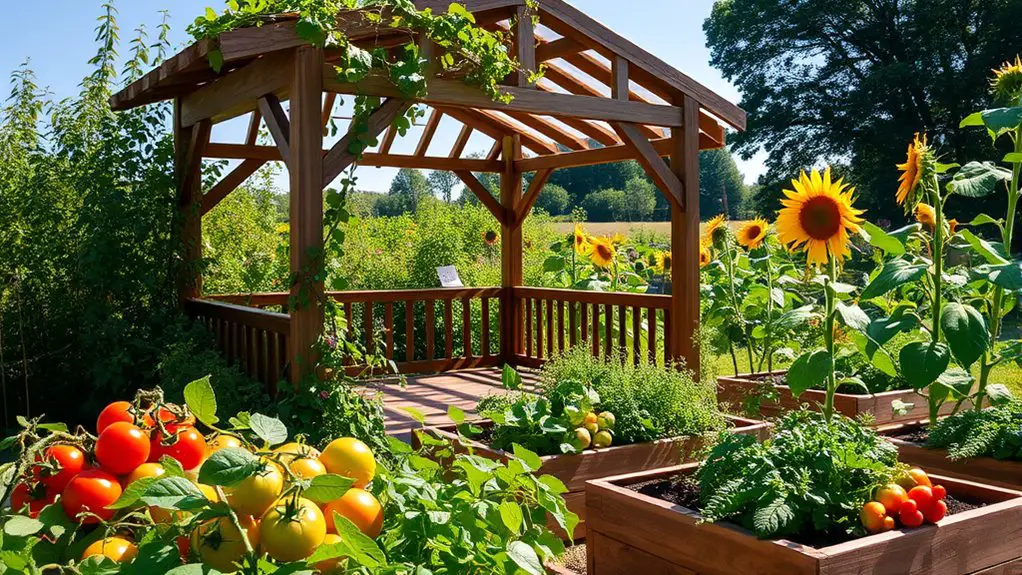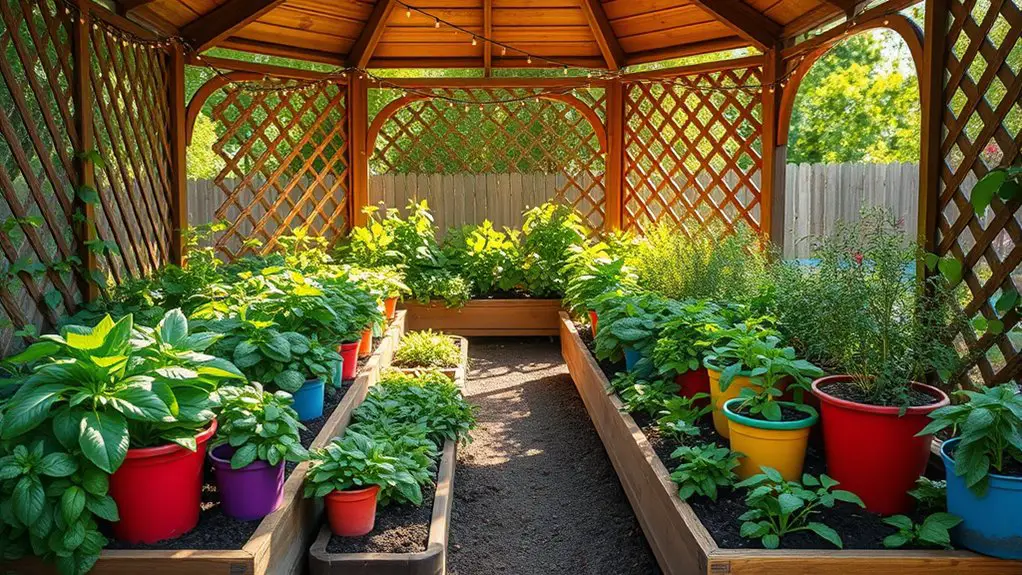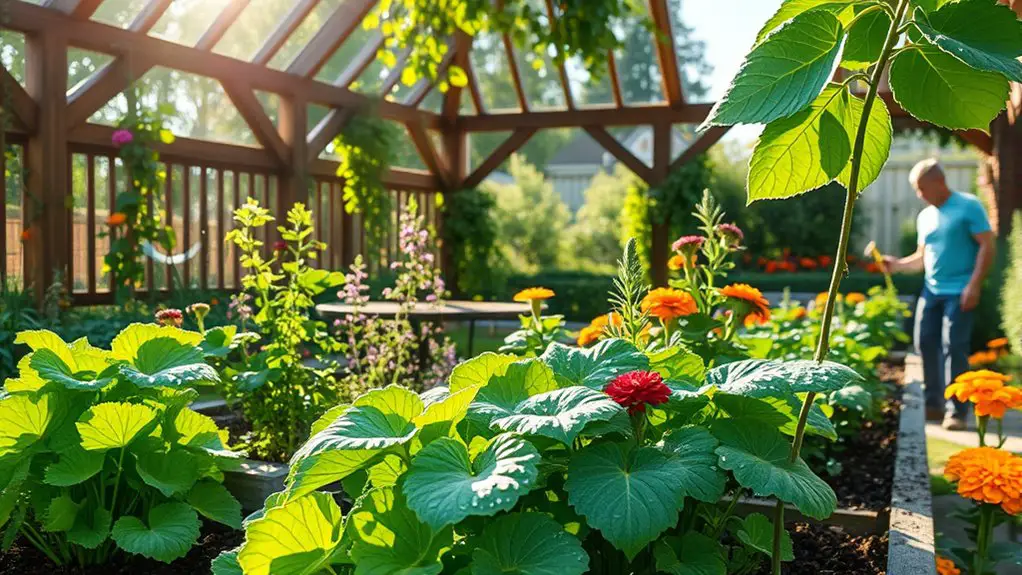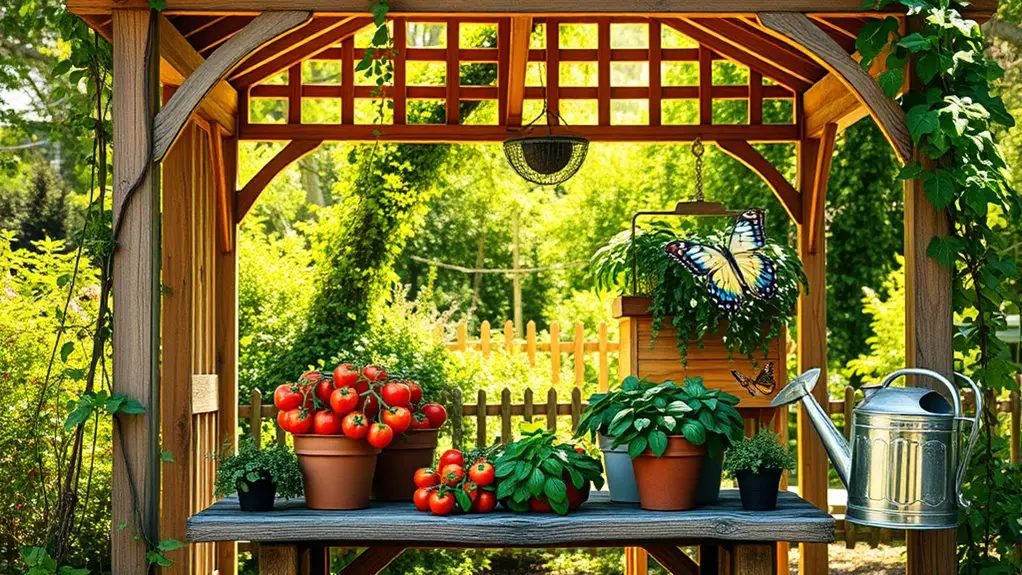To grow vegetables and herbs in your gazebo garden, start by choosing a sunny spot with good drainage. Select plants suited to your climate and group them based on their watering and nutrient needs. Prepare the soil with organic fertilizers after testing pH and nutrient levels. Implement efficient watering techniques like drip irrigation and monitor for pests regularly. By following these guidelines, you’ll guarantee a thriving garden environment and discover more tips to enhance your gardening success.
Choosing the Right Location for Your Gazebo Garden

When choosing the right location for your gazebo garden, it’s essential to contemplate factors like sunlight exposure, drainage, and accessibility. Positioning your gazebo where it can receive at least six hours of direct sunlight daily is critical for ideal plant growth. Assess the area for any shading from trees or structures that might inhibit this light.
Additionally, consider drainage; you’ll want to avoid areas where water tends to pool after rainfall. Ensuring good drainage will protect your plants from root rot and other issues.
Wind protection is another important factor. Placing your gazebo near natural windbreaks, like hedges or fences, can shield your plants from harsh winds that may hinder their growth and viability. Accessibility is also significant; make sure you can easily reach your gazebo for maintenance and harvesting. By addressing these elements, you’ll create a thriving environment for your garden.
Selecting the Best Vegetables and Herbs for Your Space
When selecting vegetables and herbs for your garden, consider the space each plant requires, as overcrowding can hinder growth and yield. Additionally, assess your local climate to guarantee the chosen varieties will thrive in your conditions. Finally, think about the culinary uses of these plants, as some herbs and vegetables can enhance your meals while providing nutritional benefits.
Space Requirements Considerations
Selecting the right vegetables and herbs for your available space is essential, as not all plants thrive in the same conditions. Consider using vertical gardening techniques or container gardening to maximize your garden’s potential. Here’s a simple guide to help you choose wisely:
| Plant Type | Space Needed | Best Method |
|---|---|---|
| Leafy Greens | 1-2 sq. ft. | Container gardening |
| Herbs | 1 sq. ft. | Vertical gardening |
| Tomatoes | 3-4 sq. ft. | Container gardening |
| Peppers | 2-3 sq. ft. | Vertical gardening |
Assess your available space and select plants that suit your gardening approach. Embrace the freedom of cultivating a thriving garden, regardless of size!
Climate Adaptability Factors
Understanding climate adaptability is essential for choosing the right vegetables and herbs for your garden, as different plants have varying tolerances to temperature, humidity, and sunlight. You’ll need to assess your local climate, particularly how temperature fluctuations and humidity levels affect plant growth. For instance, heat-loving crops like tomatoes and peppers thrive in warmer conditions, while leafy greens prefer cooler temperatures. Additionally, certain herbs, such as basil, flourish in higher humidity, while others, like rosemary, require drier environments. By selecting varieties suited to your specific conditions, you’ll guarantee a more productive garden. Keep a close eye on seasonal changes and adjust your choices accordingly to maximize your gardening success and enjoy the freedom of growing your own food.
Culinary Uses and Benefits
After determining which vegetables and herbs thrive in your local climate, the next step is to explore their culinary uses and health benefits. Each plant brings unique flavors and textures to your dishes, elevating your culinary applications. For instance, basil’s aromatic leaves are perfect for pesto, while tomatoes are essential in sauces and salads. Additionally, many herbs and vegetables offer significant health benefits. Spinach is rich in iron and vitamins, promoting overall well-being, while garlic has anti-inflammatory properties. By selecting a diverse range, you not only enhance your meals but also support your health. Combining flavors and nutritional benefits can create a vibrant, enjoyable cooking experience that aligns with your desire for freedom in the kitchen.
Preparing the Soil for Optimal Growth
Before planting, it’s vital to test your soil to determine pH levels and nutrient content. Based on the results, you can amend your soil with essential nutrients to create a fertile environment for your vegetables and herbs. This preparation guarantees ideal growth and enhances the overall health of your garden.
Soil Testing Essentials
Soil testing is a critical first step in preparing your garden for ideal vegetable and herb growth. By analyzing your soil’s pH and nutrient levels, you can identify essential adjustments needed for optimal cultivation. Start by collecting samples from different areas of your garden, ensuring you gather a representative mix. Send these samples to a local extension service or use a home testing kit. Understanding your soil’s pH helps you determine its acidity or alkalinity, which influences nutrient availability. Additionally, testing for nutrient levels, such as nitrogen, phosphorus, and potassium, informs you of any deficiencies or excesses. This knowledge empowers you to create a balanced environment, promoting healthy plant development and maximizing your gardening success.
Nutrient-Rich Amendments
Understanding your soil’s nutrient profile is only the beginning; the next step is to enrich it with the right amendments to support ideal growth for your vegetables and herbs. Start by incorporating compost, which offers numerous benefits, such as improving soil structure, enhancing moisture retention, and providing essential nutrients. Aim for a balanced mix of green and brown materials to optimize microbial activity. Additionally, consider using organic fertilizers tailored to your plants’ specific needs. These fertilizers release nutrients slowly, promoting steady growth without the risk of chemical buildup. Regularly amend your soil with these nutrient-rich options, ensuring your gazebo garden thrives naturally, enabling you to cultivate a bountiful harvest while embracing sustainable practices.
Designing Your Gazebo Garden Layout

When designing your gazebo garden layout, it’s essential to take into account both functionality and aesthetics for ideal vegetable and herb growth. Start with layout planning by mapping out your space. Consider sunlight exposure; veggies like tomatoes and peppers thrive in full sun, while herbs like mint prefer partial shade. Group plants with similar watering and nutritional needs to simplify care.
Incorporate pathways for easy access; this helps maintain the garden while ensuring you can reach your plants without trampling others. Integrate vertical gardening solutions, such as trellises, to maximize space and enhance visual appeal.
Think about color and texture; mixing leafy greens with colorful herbs can create a vibrant, inviting atmosphere. Finally, don’t forget to leave room for future expansion or experimentation. A well-thought-out garden design can provide not only fresh produce but a personal retreat to enjoy your gardening freedom.
Implementing Effective Watering Techniques
How can you secure your vegetables and herbs receive the right amount of water? Implementing effective watering techniques is vital for thriving plants. Drip irrigation systems are an excellent choice, as they deliver water directly to the roots, minimizing waste and guaranteeing consistent moisture. Installing a timer can automate this process, freeing you from daily watering chores.
For container watering, confirm each pot has drainage holes to prevent waterlogging. Water deeply but less frequently, allowing the soil to dry out slightly between watering sessions. This encourages root growth and prevents overwatering, which can lead to root rot.
Consider using mulch around your plants to retain moisture and regulate soil temperature. By combining these methods, you’ll create an efficient watering strategy that promotes healthy growth while giving you the freedom to enjoy your gazebo garden without constant maintenance.
Managing Pests and Diseases Naturally

Although pests and diseases can pose significant challenges to your vegetable and herb garden, managing them naturally can lead to healthier plants and a more sustainable growing environment. One effective strategy is to utilize natural remedies like neem oil or insecticidal soap, which target specific pests without harming beneficial insects.
Companion planting is another powerful tool. By planting certain herbs and vegetables together, you can deter pests naturally; for example, basil can repel aphids when planted near tomatoes. Regularly inspecting your plants allows you to catch any infestations early, ensuring they don’t spread.
Encourage beneficial insects, such as ladybugs and lacewings, by planting flowers like marigolds or dill nearby. These allies help manage pest populations without chemical interventions. By adopting these practices, you can create a thriving gazebo garden that flourishes in harmony with nature.
Harvesting and Maintaining Your Garden for Continued Success
To guarantee your garden continues to thrive, it is essential to harvest your vegetables and herbs at the right time and maintain ideal growing conditions. Proper harvest timing assures you pick your crops when they’re at their peak flavor and nutritional value. For example, herbs should be harvested before flowering, while vegetables like tomatoes should be picked when they’re fully colored and slightly firm.
Utilizing the right garden tools, such as sharp shears or a harvesting knife, can help you make clean cuts, reducing damage to the plants. After harvesting, monitor soil moisture and nutrient levels, adjusting watering and fertilization as needed. Regularly inspect for pests and diseases, and promptly address any issues to prevent spread. Additionally, rotating crops annually can enhance soil health and productivity. By committing to these practices, you’ll cultivate a flourishing garden that rewards you season after season.
Frequently Asked Questions
Can I Grow Vegetables and Herbs in Containers Within a Gazebo?
Yes, you can grow vegetables and herbs in containers within a gazebo. Focus on container selection for proper drainage and guarantee ideal spacing between plants for maximum growth and air circulation to maximize your gardening success.
What Types of Lighting Are Best for a Gazebo Garden?
In your lovely retreat, embracing both LED lights and natural sunlight can work wonders. LED lights provide efficiency and longevity, while natural sunlight nurtures growth, giving your plants the freedom to thrive beautifully in your gazebo.
How Do Seasonal Changes Affect My Gazebo Garden?
Seasonal changes greatly impact your gazebo garden. Spring planting requires careful timing for ideal growth, while winter preparation involves protecting plants from frost and ensuring the soil remains fertile, allowing for a thriving garden year-round.
Are There Specific Tools Needed for Gazebo Gardening?
You might be wondering what tools are essential for gazebo gardening. Proper gardening tools can make all the difference, ensuring efficient gazebo maintenance while helping you cultivate your green paradise. Don’t underestimate their importance!
Can I Incorporate Ornamental Plants Alongside Vegetables and Herbs?
Absolutely, you can incorporate ornamental plants alongside vegetables and herbs. Their benefits include attracting beneficial insects and improving aesthetics, while ensuring vegetable compatibility helps maintain healthy growth and minimizes pest issues in your garden.

